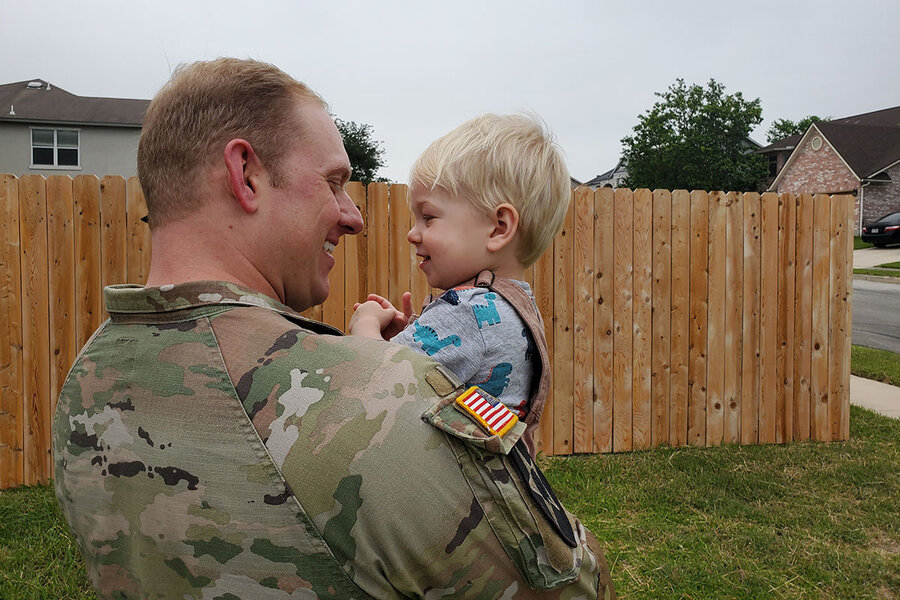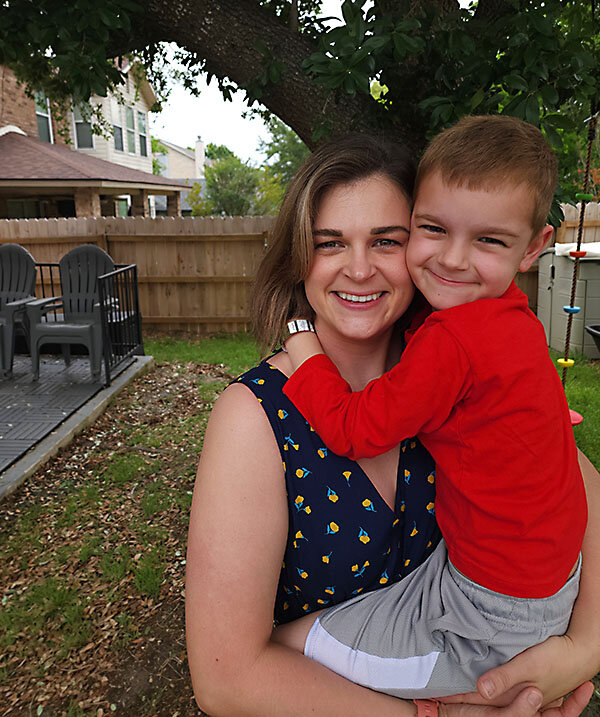Military families need more child care. Can Pentagon deliver?
At a time when recruiting and retaining troops is becoming an urgent challenge for the Pentagon, more access to child care is increasingly seen as a must for military families. Defense officials, for their part, have promised that it’s a priority.
The question is whether they can make it happen. Kayla Corbitt hopes so, but her experience with the system has not been without frustration. This came as a surprise. When she married her military husband after meeting him in graduate school, though she was a bit hazy on the array of services available to military families, her general impression was that they were “wonderful.”
The couple’s first postings belied that belief. When she got pregnant, Ms. Corbitt quit her job on base in Italy due to “such limited access” to child care. She worked hard to learn the ins and outs of applying for day care spots within the military system, however, and figured she would navigate it like a champ when her family was posted to the Washington, D.C., area in 2019.
Why We Wrote This
A story focused onNew child care efforts aim to provide more options for military families, especially at a time of recruiting challenges. But the Pentagon has fallen short of past promises for care help.
She didn’t. Child care resources for military families in the region weren’t enough “to meet even half of the demand,” Ms. Corbitt says. She spent $7,000 in out-of-pocket expenses for waitlist fees and deposits that were never reimbursed. In the absence of care, Ms. Corbitt quit her new job. It was a year before she lined up another one with a place for her child.
The Pentagon has been busy building more child care centers and increasing incentives for day care workers to fill chronic staffing shortages and help get parents off long waitlists. There are other initiatives, too. The National Guard this year launched a pilot program to make child care free during weekend drills, and the Pentagon has announced a trial plan to fly in grandparents to care for kids if the waitlist at a base facility exceeds one month.
Defense officials realize that they have overpromised and underdelivered in the past, military family advocates say. The challenge going forward, they add, is ensuring the Pentagon delivers on the services it advertises.
Secretary of the Army Christine Wormuth has noted that as a mother herself, she understands “how hard” child care can be to find, “and how expensive it can be when you find it.”
Shortening lengthy waitlists
In the absence of immediate care options, many military families have little choice but to wait. The cost of child care in the United States nearly doubled between 1985 and 2011 alone, according to the Census Bureau. This puts most “high-quality civilian child care centers” out of reach for many service members, particularly the junior enlisted ranks, according to the Congressional Research Service.
Meanwhile, the U.S. military is having difficulty meeting recruitment goals. The Army missed its target by 15,000 people last year, and the Air Force, Marine Corps, and Navy are also struggling amid a decline in interest and eligibility.
Because the Pentagon doesn’t want to lose expensive-to-train talent, it operates the largest employer-sponsored child care program in the U.S., serving some 160,000 children and employing more than 23,600 workers at an annual cost of more than $1 billion.
It is subsidized, and waitlists can stretch on for months. The Pentagon is aiming to reduce these rolls by, among other things, building more than a dozen new child care centers nationwide with funds from the latest Pentagon spending bill. This construction takes, on average, three years to complete.
The physical buildings, however, are less a problem than chronic staffing shortages. Background checks alone can be “very lengthy,” taking upward of nine months to complete, says Caitlin Hamon, former deputy director of government relations at the National Military Families Association.
For this reason, Secretary of Defense Lloyd Austin last year announced that the Pentagon’s budget would include measures to recruit and retain child care workers by allowing them to enroll their own children in the centers at a 50% discount.
They also get top priority for spaces at the base facilities where they work, ahead even of single military parents and dual military couples.
Because military families move every three years or so, the Pentagon is also putting in place programs to reimburse service members for child care costs related to their frequent relocations.
If they can’t get child care within 30 days of arriving in a new home, for example, the military will give $500 to U.S.-based troops or $1,500 for those posted overseas to fly out a family member or another trusted caregiver.
Still, “asking a family member to give up what they’re doing and take care of your kids for free isn’t a great solution,” says Ms. Corbitt, who launched a nonprofit, Operation Child Care Project, to help, among other things, get information about navigating the system to military families. The organization also provides scholarships to help families pay waitlist or application fees during periods of transition.
“It’s frequently less than $1,500 that makes the difference between spouses being able to keep a job or finish school” and having child care, she adds.
Relying on “unpaid labor”
After coming to the U.S. from El Salvador as a young girl, Patty Barron watched her mother, a recent widow, struggle to find a place for her children during the long hours she worked to put food on the table.
“Child care was wherever she could find it, with whomever she could find it. Sometimes it was great, and sometimes it wasn’t so great,” Ms. Barron recalls. By the time she was 10 years old, Ms. Barron was caring for her younger brother and sister.
Today, as the deputy assistant secretary of defense for military community and family policy, she is the Pentagon’s point person overseeing military child care policy – and a working military spouse who for years had a personal perspective on day care.
“I followed my soldier for 30 years, and I can tell you that I don’t see a change in demand.” That’s in large part because, then as today, roughly 40% of active duty service members have children. Of those kids, the largest percentage are age 5 and under.
“So you can imagine how important it is to have access to affordable, quality care,” Ms. Barron notes.
In 1978, the Defense Department took formal responsibility for establishing child care centers for its troops. In the 1980s, the military began putting more money into them after an investigation found the majority of Pentagon day care centers didn’t meet safety codes or comply with “sanitation standards.”
Today, demand for these services far outstrips supply. “They’re great when you can access them,” says Ms. Corbitt, who estimates that in her experience fewer than 30% of military parents are able to land a place in on-base care.
In the meantime, she says, much like decades before, the military still “relies heavily on the unpaid labor of spouses” to pick up the slack.
Promising start to pilot programs
Within the halls of the Pentagon, officials say they are most encouraged by pilot programs to expand day care availability.
Previously the only centers the Pentagon deemed eligible for reimbursement were the roughly 10% of licensed child care programs in America that are nationally accredited.
“That’s a low number,” says Stacey Young, who as director of the Pentagon’s Office of Military Family Readiness Policy oversees child development programs.
“Accreditation isn’t cheap,” she adds. “But just because a program isn’t accredited doesn’t mean it’s not a quality program. ... We really needed to find a way to expand our capacity.”
The trick is to do it without sacrificing quality. In that quest, the Pentagon has begun “piggybacking” onto programs that states already have in place to measure and improve their centers – including providing quality ratings – and then “crosswalking it” with Pentagon standards, Ms. Young says.
If they align, military families are eligible for reimbursement. Currently the program, which ramped up post-pandemic, is in nine states and counting.
For Ms. Barron, the Pentagon bears a responsibility to ensure military families have good care wherever and whenever they need it. “What you don’t want is what my mom experienced,” she says.
Making sure military service members can focus at work, she argues, is a national security necessity, and spouses – many of whom work at child care centers – know that too, Ms. Barron adds.
“They bring an awful lot of love and attention to our kids, because they understand the lifestyle,” which – with frequent moves for children and parents often away on assignments – “is not easy.”
Editor's Note: This article has been updated to clarify the name of Operation Child Care Project.











